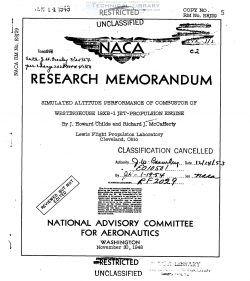naca-rm-e8j29
- Version
- 102 Downloads
- 1.46 MB File Size
- 1 File Count
- April 21, 2017 Create Date
- April 21, 2017 Last Updated
National Advisory Committee for Aeronautics, Research Memorandum - Simulated Altitude Performance of Combustor of Westinghouse 19XB-1 Jet Propulsion Engine

A lSXB-l combustor was Operated under conditions simulating
zero-ram operation of the lSXB-l turboJet engine at various altitudes
and engine speeds. The combustion efficiencies and the altitude
operational limits were determined; data were also obtained on the
character of th combustion, the pressure drop through the combustor,
and the combustor-outlet temperature and velocity profiles.
At altitudes about 10,000 feet below the operational limits, the
flames were yellow and steady and the temperature rise through the
combustor increased with fuel-air ratio throughout the range of fuel-
air ratios investigated. At altitudes near the operational limits,
the flames were blue and flickering and the combustor was sluggish in
its response to changes in fuel flow. At these high altitudes, the
temperature rise through the combustor increased very slowly as the
fuel flow was increased and attained a maximum at a fuel-air ratio
much leaner than the over-all stoichiometric; further increases in
fuel flow resulted in decreased values of combustor temperature rise
and increased resonance until a rich-limit blow-out occurred.
The approximate operational ceiling of the engine as determined
by the combustor, using AN—F-ZB, Amendment-3, fuel, was 30,400 feet
at a simulated engine speed of 7500 rpm and increased as the engine
speed was increased. At an engine speed of 16,000 rpm, the opera—
tional ceiling was approximately 48,000 feet. Throughout the range
of simulated altitudes and engine speeds investigated, the combustion
efficiency increased with increasing engine speed and with decreasing
altitude.
The combustion efficiency varied from over 99 percent at
operating conditions simulating high engine speed and low altitude
operation to less than 50 percent at conditions simulating operation
at altitudes near the operational limits. The isothermal total-
pressure drop through the combustor was 1.82 times as great as the
inlet dynamic pressure. As expected from theoretical considerations,
a straight-line correlation was obtained when the ratio of the com-
bustor total-pressure drop to the combustor-inlet dynamic pressure
was plotted as a function of the ratio of the combustor-inlet air
density to the ccmbustcr-outlet gas density. The combustor-outlet
temperature profiles were, in general, more uniform for runs in which
the temperature rise was low and the ccmbustion efficiency was high.
Inspection of the combustor basket after 36 hours of operation showed
veryr little deterioration and no appreciable carbon deposits.
| File | Action |
|---|---|
| naca-rm-e8j29 Simulated Altitude Performance of Combustor of Westinghouse 19XB-1 Jet Propulsion Engine.pdf | Download |

Comment On This Post